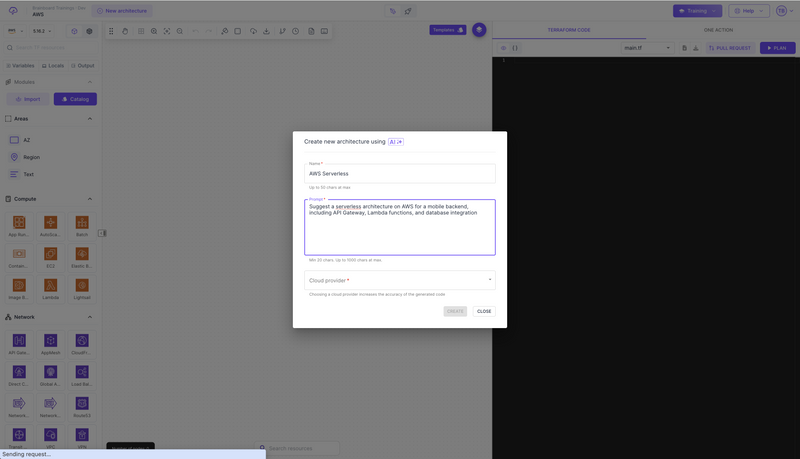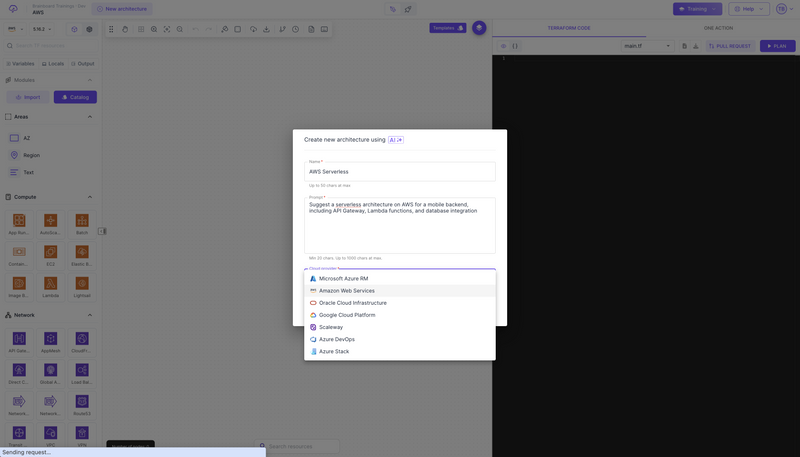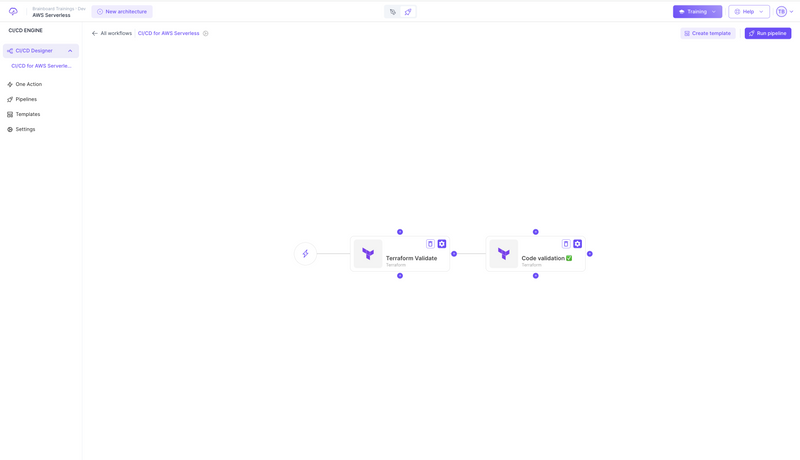Generating cloud infrastructures with AI involves automating the process of provisioning and managing cloud resources using artificial intelligence techniques. Here's a medium-level overview of the steps involved in generating cloud infrastructures with AI:
I. Define Your Requirements
Start by defining your infrastructure requirements. Determine what type of applications or services you want to deploy, the scale of your infrastructure, and any specific performance, security, or compliance requirements.
The prompt I used in the example: "Suggest a serverless architecture on AWS for a mobile backend, including API Gateway, Lambda functions, and database integration."
II. Choose Your Cloud Provider
Select a cloud provider that aligns with your needs (e.g., AWS, Azure, Google Cloud, etc.). Different providers offer various services and features, so choose one that best suits your project.
III.Infrastructure as Code (IaC)
Use IaC to define your cloud infrastructure in code. IaC allows you to create, update, and manage cloud resources in a reproducible and automated way.
IV. Testing and Validation
Before deploying your AI-driven infrastructure into production, thoroughly test and validate it to ensure that it meets your requirements and performs as expected. Consider using Terraform Validate and Terraform Plan.
V. Continuous monitoring
Implement continuous monitoring of your infrastructure to help you detect anomalies, security threats, and understand the cost of your infrastructure in real-time. Tools like Tfsec, Terrascan, and Infrascost can be used for monitoring.
By following these steps, you can leverage AI to automate the generation, management, and optimization of your cloud infrastructure, making it more efficient, cost-effective, and responsive to changing demands.
VI. Documentation
Maintain comprehensive documentation for your AI infrastructure and provide training to your team to effectively manage and operate the infrastructure.
VII. Example of Prompts
When using AI to generate cloud infrastructure ideas or configurations, you can provide prompts that specify your requirements, preferences, or the context of the infrastructure you need. Here are some examples of prompts that you might use:
- Basic Cloud Setup: "Design a basic cloud infrastructure for a small startup using AWS. Include a web server, database, and basic security measures."
- Scalable E-commerce Platform: "Create a scalable cloud infrastructure plan for an e-commerce website on Azure, focusing on high availability and load balancing."
- Hybrid Cloud Configuration: "Suggest a hybrid cloud infrastructure that integrates on-premises data centers with Google Cloud services for a financial institution."
- Cost-Effective Solution for Non-Profit: "Propose a cost-effective cloud infrastructure on AWS for a non-profit organization, ensuring low maintenance and ease of use."
- High-Performance Computing (HPC): "Outline a cloud infrastructure on AWS for high-performance computing tasks, including compute-optimized instances and storage solutions."
- Disaster Recovery Plan: "Develop a disaster recovery plan for a cloud infrastructure on Microsoft Azure, ensuring data redundancy and minimal downtime."
- IoT Device Management: "Design a cloud infrastructure on Google Cloud Platform for managing IoT devices, with a focus on data processing, storage, and security."
- AI and Machine Learning Workloads: "Create a cloud infrastructure layout on AWS for AI and machine learning workloads, including necessary compute and GPU resources."
- Multi-Region Deployment: "Plan a multi-region deployment on Azure for a global application, focusing on latency reduction and regional compliance."
- Serverless Architecture: "Suggest a serverless architecture on AWS for a mobile backend, including API Gateway, Lambda functions, and database integration."
- Secure Financial Services Infrastructure: "Propose a secure and compliant cloud infrastructure on AWS for a fintech company, with emphasis on encryption and regulatory compliance."
- Media Streaming Service: "Outline a cloud infrastructure for a high-traffic media streaming service on Azure, ensuring efficient content delivery and caching."
- Big Data Analytics: "Develop a cloud infrastructure plan on AWS for big data analytics, including data lakes, ETL processes, and analytics tools."
- Mobile App Hosting: "Suggest a cloud hosting solution on Google Cloud for a rapidly growing mobile application, focusing on scalability and database performance."
Remember, the more specific your prompt is regarding your needs and constraints, the more tailored and useful the response will be.
Request your access now and start building your cloud infrastructures with AI on Brainboard here.









Top comments (0)